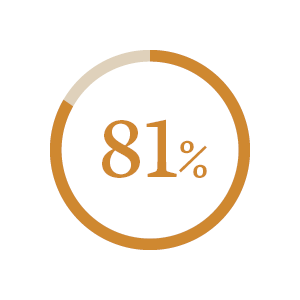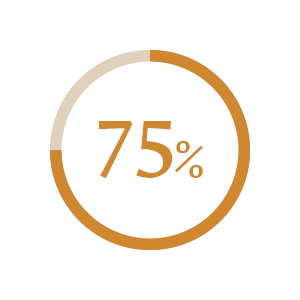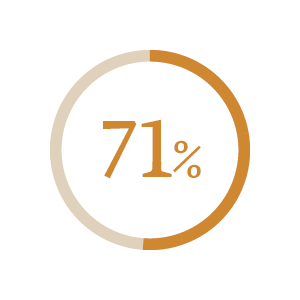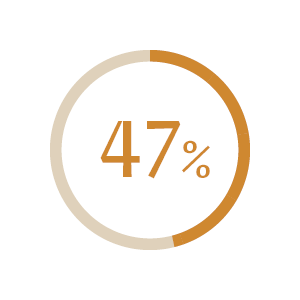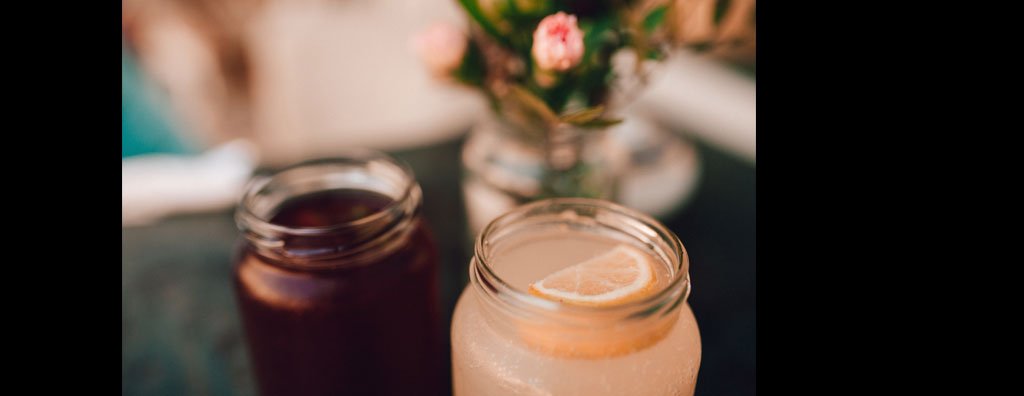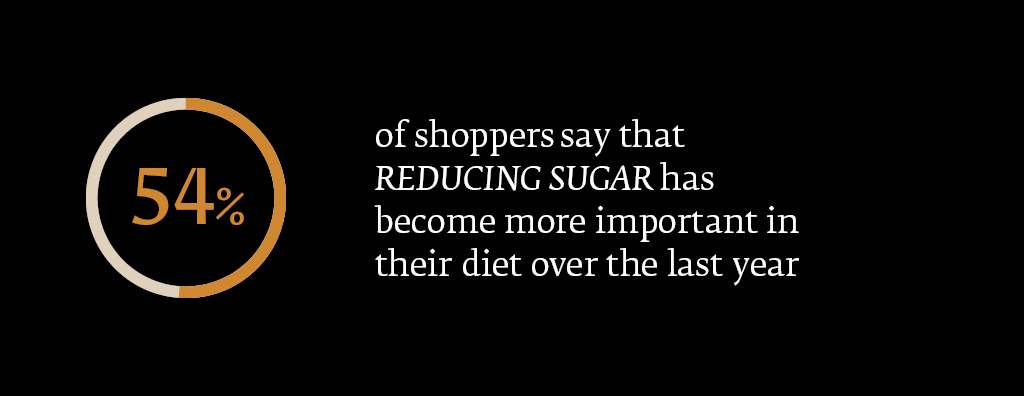
Welcome to lesson 01:
The experience of mindful eating
 |
Brought to you by a sugar reduction expert: Marcela Serrano |
We've got a confection to make – your first lesson is jam-packed with useful knowledge. Here, you'll learn about: perceptions of sugar, customer health aspirations, key global facts and trends.
Ready?
How many times do we find ourselves ‘swallowing’ food in a hurry? Eating while standing or walking just to stop the stomach from growling? How many times do we have lunch while at work, or while on the phone or chatting with friends and colleagues on whatsapp, or while resolving work issues in front of our computer without paying the slightest attention to the dish we are eating?
At the cinema, how many times do we crave something sweet, like a bag of popcorn? Suddenly, before the movie even starts we realise the packaging is empty – we ate it all! Whenever we repeat this type of behaviour, our perception of hunger and satiety can change.

When under stress, we tend to consume more food and beverages that contain sugar¹. In the US, adults ate about 14% more added sugars after the emergence of COVID-19 compared to before the pandemic.
Mindful eating and drinking, or eating and drinking with mindfulness, is a tool that helps change eating behaviour based on the mindfulness meditative practice, a state of awareness and attention to what we are doing and feeling.
Food beliefs are changing and shaping consumer eating habits. More and more people now carefully consider what to eat, and increasingly take nutritional information into account before purchasing a product. Consumers have new food beliefs and are increasingly mindful about the food they eat, in particular many consumers watch the amount of added sugar they consume. The trend is moving towards more natural and less processed food and beverages, short ingredient lists that are representing the clean label movement and ‘free from’ products. Driven by new food beliefs, balanced diets are competing with special diets. New ingredients, from ancient grains to superfoods, promise novelty and health benefits to consumers, and allow manufacturers to experiment and innovate.
There are three pillars impacting consumers’ consumption behaviour of sugary products:
 |
1. Healthy eating habits
The trend for healthy eating has turned towards finding a balanced nutrition. Consumers aim at reducing their consumption of ‘negative’ nutrients such as sugar, salt or carbohydrates in their diets, while they are trying to increase their consumption of ‘good’ nutrients such as fibre and protein.
Some consumers aim for a healthy diet, but still want to indulge with full sugar products from time to time (permissible indulgence). Other consumers are looking for food and beverages containing less sugar, yet want to have a pleasurable experience.
 |
2. Cultural differences
When it comes to sweet food and beverages, consumers’ individual needs, expectations and preferences vary drastically, country by country. As a result, we see a wide variety of product offering on the market, catering to all those needs.

EUROPE and MIDDLE EAST (EAME)
|
|
|
|
|
|
of EAME consumers |
of EAME consumers |
of German consumers |
of UK consumers |
NORTH AMERICA (NOAM)
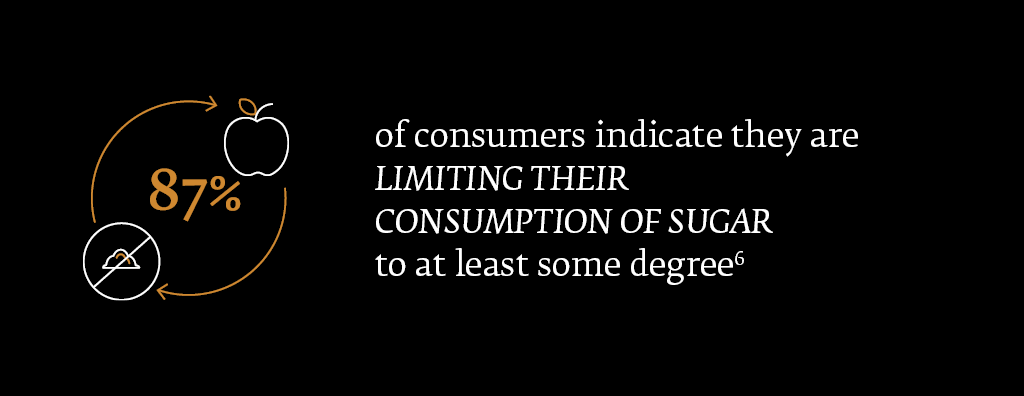
59% of consumers limit their sugar intake due to future health concerns6.
Innova’s 2018 survey of US consumers found that 3 out of 5 consumers are following a sugar reduction strategy – meaning they would rather cut back on sugar consumption than consume alternative sweeteners.
LATIN AMERICA (LATAM)
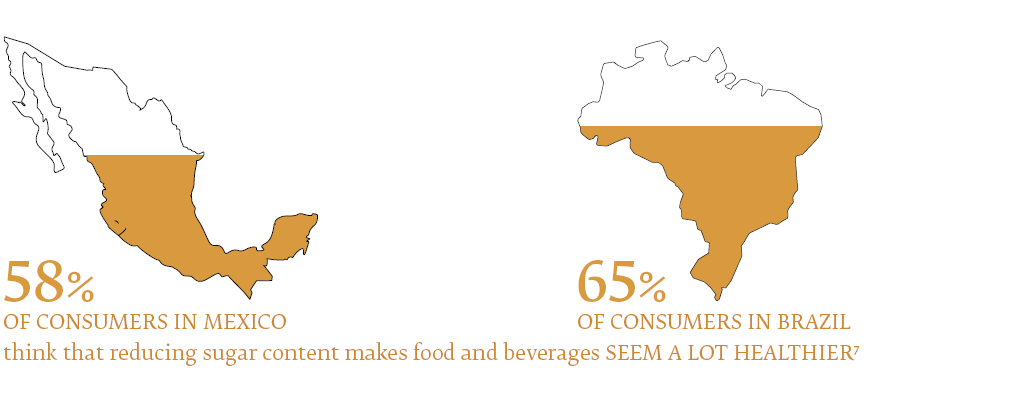
Moreover, in Mexico, 47% of consumers mentioned that they are reducing sugar in their diet – by choosing foods that contain less sugar. In Brazil, the number is 54%.
ASIA PACIFIC (APAC)
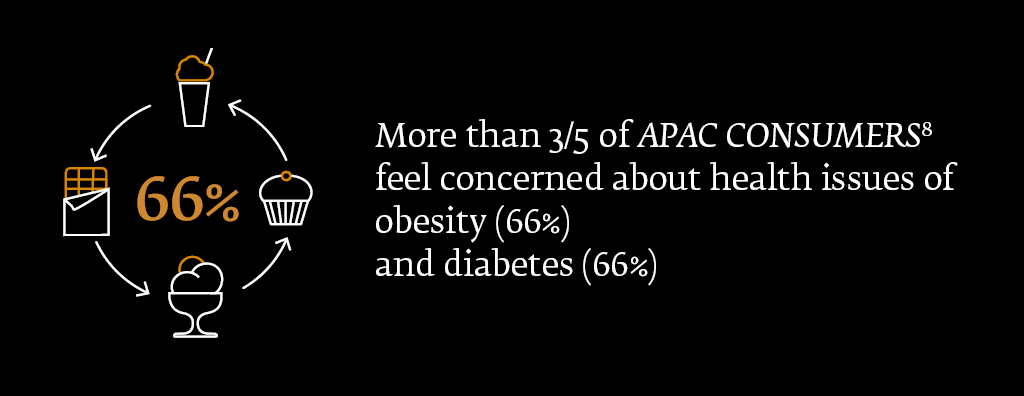
Australian consumers actively make food and drink choices to help prevent poor health conditions: 44% avoid sugar in their diet and 56% choose not to buy sugar as they believe it is harmful to the health of their family.
 |
3. Government interventions
The World Health Organization (WHO) considers that sugar-sweetened beverage consumption plays a key role in free sugars intake, particularly by children and teenagers, and recommends reducing this intake to less than 10% of total energy intake (WHO, 2015). Therefore, several countries have been taking actions to reduce the consumption of sugary drinks, to drive industries to reformulate these products and educate consumers to choose healthier alternatives.
Some measures are restrictive, like labelling the excess of sugar especially when aimed at children (Mexico, Chile) effectively limiting it at 2%, labelling the amount of added sugar with and % daily value 50g/day/person (US). Others are tax driven, in the hope to guide consumers to healthier food choices. Europe chose the Nutriscore system, which aims at guiding consumers to understand what they eat, and help them make healthier food choices. It is likely we will see more packaging label warnings like in Mexico spreading to more countries around the world. Singapore is experimenting as well.
Numerous governments have applied sugar taxes, in an attempt to improve public health. The past two years have seen sugar taxes imposed or expanded in Malaysia, the UAE, Thailand, Saudi Arabia, Italy, Croatia and Poland, with several other countries considering following suit. The style and coverage of levies is variable, with flat taxes, tax levies based on absolute sugar content and threshold levies all used. In most cases the taxes apply to sugar sweetened beverages.
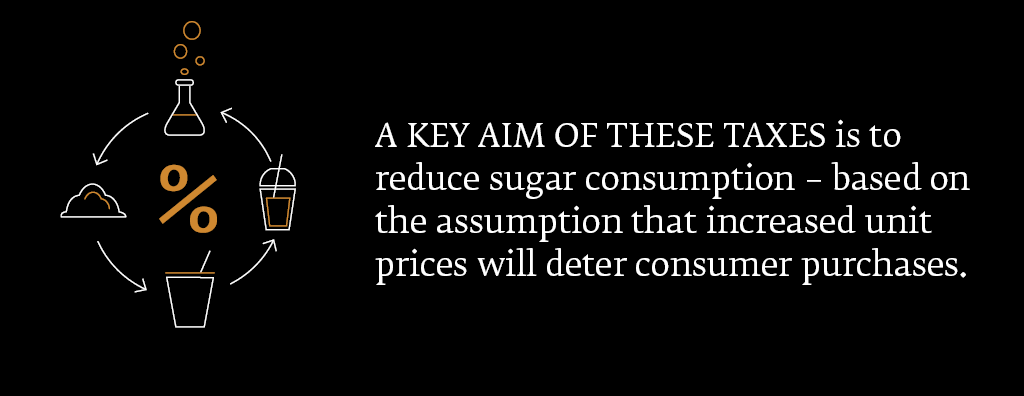
As indicated, many consumers are already looking to eschew sugar, and taxes have accelerated that shift. Euromonitor’s Nutrition system shows that in the UAE, following the implementation of a sugar tax on carbonates and energy drinks in 2017, total sugar consumption through carbonates decreased by 9% between 2017 and 2018 and by 7% between 2018 and 2019, suggesting the tax did change consumer behaviour.
Conclusion
Consumers, especially younger ones, regard sugar the way previous generations viewed fat.
The concern with excessive sugar consumption is truly universal. Unlike many other food and beverage product trends that come and go, the trend for sugar reduction is changing consumer behaviour in significant ways. It’s imperative food producers strive to reduce added sugars, re-examine sugar levels and invest in new sweetener science and solutions that are appropriate by category to better serve public health.
Sources
https://blog.euromonitor.com/mindful-eating-and-the-new-food-beliefs/
https://www.who.int/
1 Health Focus 2018 International Trend Study
2 Givaudan War on Sugar research, 7 markets (France, Germany, Netherlands, Poland, Russia, South Africa, UK), n=1000. (16-65 years old)
3 Givaudan War on Sugar research, 7 markets (France, Germany, Netherlands, Poland, Russia, South Africa, UK), n=1000. (16-65 years old)
4 Givaudan consumer study 2018, Germany, n=200
5 Givaudan Better4U beverages study - UK (30-45 years old) Base = CSD drinkers in UK (807)
6 Mintel’s Sugar and Sweeteners – US
7 According to Health Focus International 2020
8 Givaudan Social Listening study, APAC
